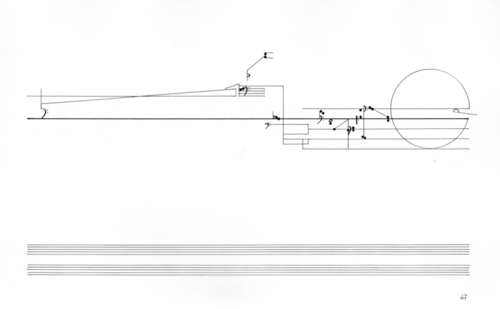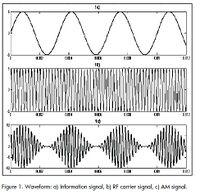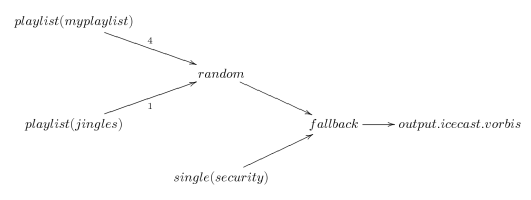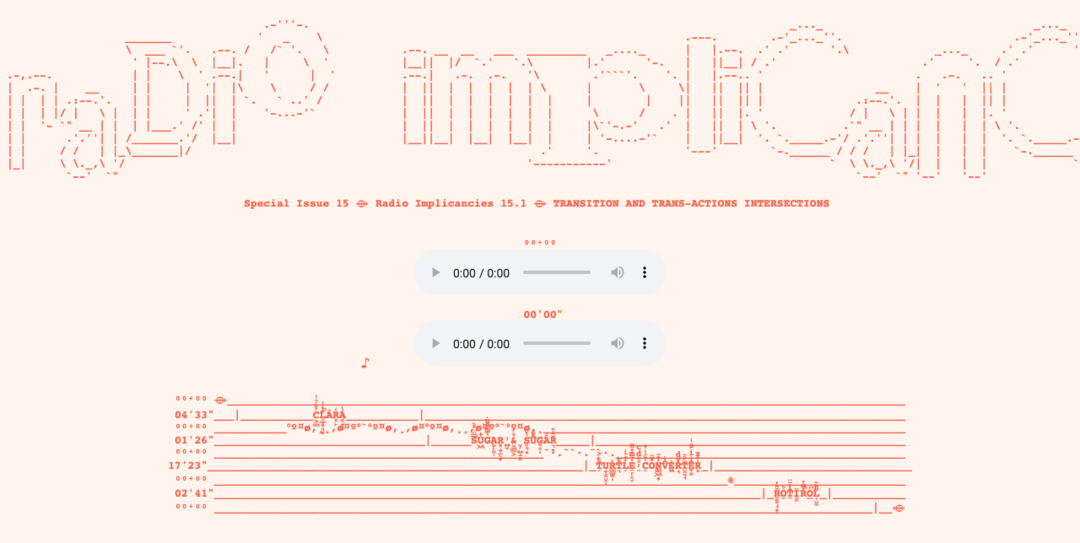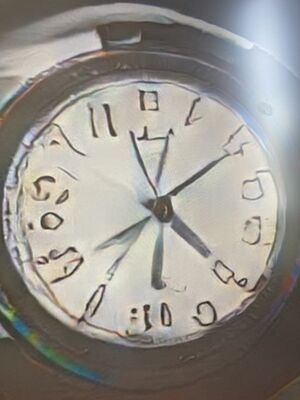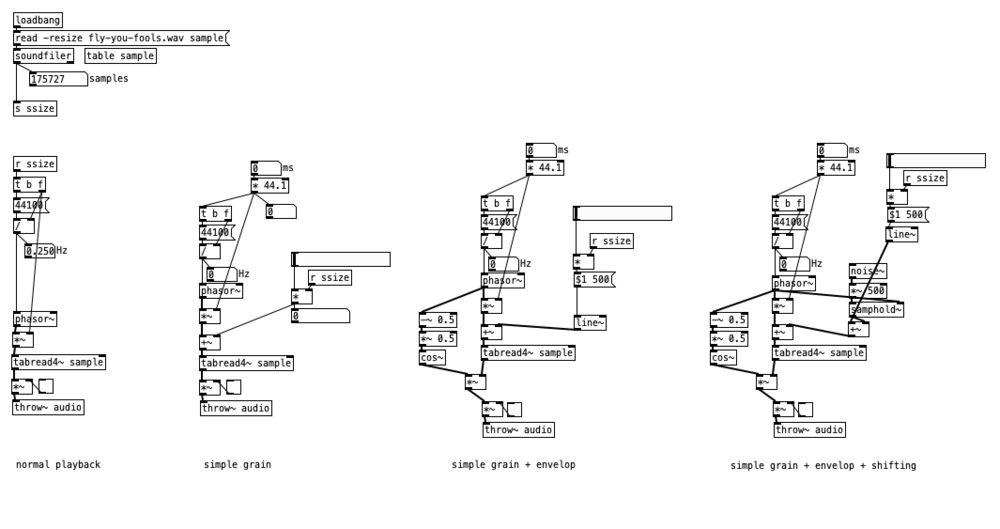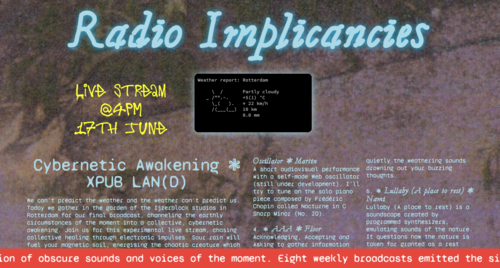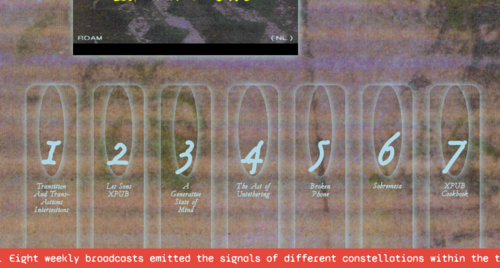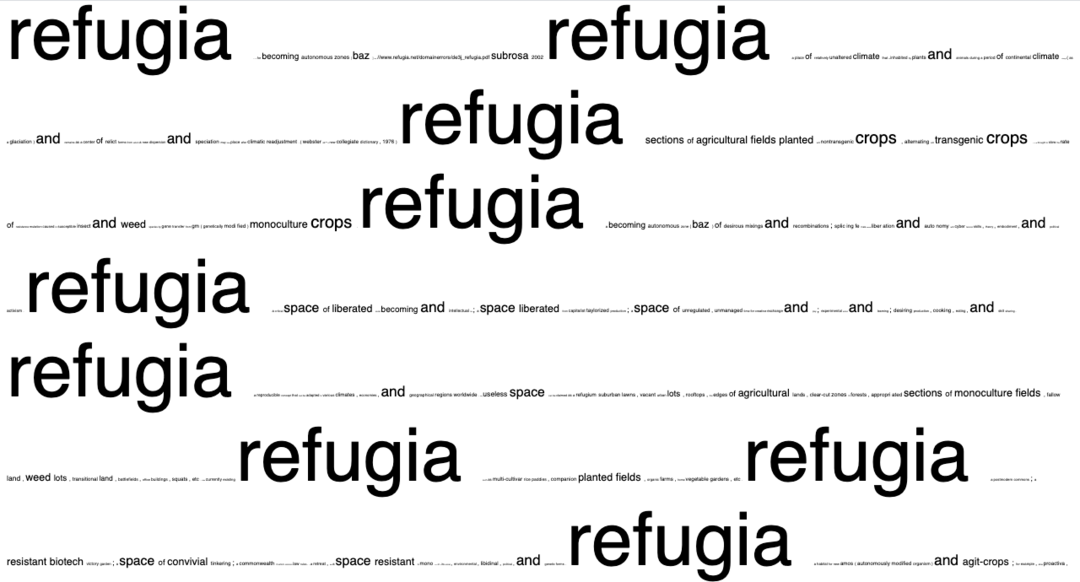User:Jacopo/Radioimplicancies: Difference between revisions
| (35 intermediate revisions by the same user not shown) | |||
| Line 1: | Line 1: | ||
[[File:Treatise-cornelius-cardew.png|500px|thumb|right|Treatise by Cornelius Cardew]] | |||
=Radio Implicancies= | =Radio Implicancies= | ||
[[File:Frequencies2.jpeg|200px|left]] | [[File:Frequencies2.jpeg|200px|left]] | ||
| Line 6: | Line 7: | ||
'''Every Thursday afternoons, Radio Implicancies broadcasts from 16:00-17:00''' | '''Every Thursday afternoons, Radio Implicancies broadcasts from 16:00-17:00''' | ||
[[File:Basic-radio-graph.png|right]] | |||
These public broadcasts are ongoing experiments with a specific subset of technological tools for sharing and formatting knowledge. Radio Implicancies will use any means necessary i.e. different protocols and editorial approaches: audio streaming, live-on-tape, DJ-ing, on-line reading groups, web-rtc, liquid soap, podcasts, xmpp chat, … | These public broadcasts are ongoing experiments with a specific subset of technological tools for sharing and formatting knowledge. Radio Implicancies will use any means necessary i.e. different protocols and editorial approaches: audio streaming, live-on-tape, DJ-ing, on-line reading groups, web-rtc, liquid soap, podcasts, xmpp chat, … | ||
| Line 11: | Line 14: | ||
* https://pzwiki.wdka.nl/mediadesign/Category:Implicancies | * https://pzwiki.wdka.nl/mediadesign/Category:Implicancies | ||
[[File: | ==First Broadcast== | ||
The first webpage created for the Radio Implicancies broadcast. <br> In this first episode I wanted to play around the idea of coexistence of two different running broadcasts. I learned how to use Liquidsoap and include the broadcast in a HTML page, in this case hosted on Sandbot. | |||
[[File:Implicancies1.png|1080px|center]] | |||
== Spacing in Time == | |||
[[File:Clock.jpg|300px|thumb|right|]] | |||
Week 3. <br> | |||
In a system dominated by measures, demanding an ever increasing synchronization between individuals and their environments, we propose "Spacing in Time" as a way to escape per-determined variables. Through these audio experiments, we encounter a new moment of experiencing different time flows. The radio turns into a time's perception box where various tools for time measurement and orientation are being de-fragmented and re-boot. While creating audio environments with sound repetitions, reverbs and echoes, the experiments lead to a sense of physicality which allows the full immersion into a broadcasted, time travelling. Shut down the clocks and de-synchronize yourself from the established recognition of time, while un-practicing your common perceptions. | |||
<br> | |||
I collected some audio-experiments [https://hub.xpub.nl/sandbot/Spacing%20in%20Time/spacingintime.html here]. | |||
== The Act of Untethering == | |||
"The Word of Unbinding" by Ursula K. Le Guin was the starting point for a broadcast that turned into a psy-fantasy novel, where I was creating the full sound themes with Pure Data and Granular Synthesis. | |||
"You are stuck in the system. Desperate for connection outside of your confined space, you attempt to trick the system through transformation. What you do not realise is that the force you are blocked by is not matter made from flesh and blood. Nothing can trick the operator, as it is all-encompassing and penetrating every inch of the prison you have found yourself in. Only by giving up the encounter and deciding to leave the platform, you find yourself in a space where you are able to understand the facade of the system instead of being tethered to it." | |||
* From https://hub.xpub.nl/sandbot/SI15/Radio_4/ | |||
[[File:Granular-synthesis.png|center|1000px]] | |||
== Cybernetic Awakening == | |||
I curated the identity and the .index together with Camilo. The page we built is working as an online archive, collecting all the previous episodes while providing the space for the last broadcast. | |||
[[File:rindex1.png|left|500px]] | |||
[[File:rindex2.png|right|500px]] | |||
== Pure Data == | |||
Pd is a real-time graphical programming environment for audio and graphical processing. It resembles the Max/MSP system but is much simpler and more portable; also Pd has two features not (yet) showing up in Max/MSP: first, via Mark Dank's GEM package, Pd can be used for simultaneous computer animation and computer audio. Second, an experimental facility is provided for defining and accessing data structures. | |||
Pd can easily work over local and remote networks to integrate wearable technology, motor systems, lighting rigs, and other equipment. It is suitable for learning basic multimedia processing and visual programming methods as well as for realizing complex systems for large-scale projects. | |||
Algorithmic functions are represented in Pd by visual boxes called objects placed within a patching window called a canvas. Data flow between objects are achieved through visual connections called patch cords. Each object performs a specific task, which can vary in complexity from very low-level mathematical operations to complicated audio or video functions such as reverberation, FFT transformations, or video decoding. Objects include core Pd vanilla objects, external objects or externals (Pd objects compiled from C or C++), and abstractions (Pd patches loaded as objects). | |||
Algorithmic functions are represented in Pd by visual boxes called objects placed within a patching window called a canvas. Data flow between objects are achieved through visual connections called patch cords. Each object performs a specific task, which can vary in complexity from very low-level mathematical operations to complicated audio or video functions such as reverberation, FFT transformations, or video decoding. | |||
===Documentation=== | |||
* http://msp.ucsd.edu/Pd_documentation/index.htm | |||
* http://msp.ucsd.edu/Pd_documentation/x2.htm | |||
* http://puredata.info/ | |||
== Configuration == | == Configuration == | ||
With Liquidsoap (Terminal) | With Liquidsoap (Terminal) | ||
* playlist.liq | |||
* playlist.m3u (txt) | |||
* Terminal (liquidsoap) | |||
Liquidsoap Cookbook: https://www.liquidsoap.info/doc-1.4.4/cookbook.html | |||
[[File:Schermata 2021-04-14 alle 18.10.39.png|center|500px]] | [[File:Schermata 2021-04-14 alle 18.10.39.png|center|500px]] | ||
First configuration: https://hub.xpub.nl/sandbot/SI15/radio.html | |||
* playlist.liq: | * playlist.liq: | ||
| Line 23: | Line 69: | ||
set("log.file",false) | set("log.file",false) | ||
set("log.stdout",true) | set("log.stdout",true) | ||
# playlist can be changed to other commands | |||
myradio = audio_to_stereo(playlist("playlist.m3u")) | myradio = audio_to_stereo(playlist("playlist.m3u")) | ||
| Line 76: | Line 122: | ||
</syntaxhighlight> | </syntaxhighlight> | ||
= Tf-Idf = | |||
'''Term Frequency (TF)''': | |||
The number of times a word appears in a document divded by the total number of words in the document. Every document has its own term frequency. | |||
'''Inverse Data Frequency (IDF)''': | |||
The log of the number of documents divided by the number of documents that contain the word w. Inverse data frequency determines the weight of rare words across all documents in the corpus. | |||
[[File:Ti-idf-try.png|1080px|center]] | |||
= Setup Python on terminal (Mac) = | |||
install brew | |||
<syntaxhighlight lang="python"> | |||
/bin/bash -c "$(curl -fsSL | |||
https://raw.githubusercontent.com/Homebrew/install/HEAD/install.sh)" | |||
</syntaxhighlight> | |||
<syntaxhighlight lang="python"> | |||
brew install python3 | |||
</syntaxhighlight> | |||
<syntaxhighlight lang="python"> | |||
pip3 install NLTK | |||
</syntaxhighlight> | |||
= The Hackchat = | |||
Hackchat is a minimal, distraction-free chat application. | |||
Channels are created, joined and shared with the url, create your own channel by changing the text after the question mark. | |||
If you wanted your channel name to be 'your-channel’: https://hack.chat/?your-channel | |||
There are no channel lists, so a secret channel name can be used for private discussions. | |||
<br> | |||
* https://hack.chat/ | |||
=[https://sonic-pi.net/ Sonic Pi]= | |||
Follow the tutorial: https://sonic-pi.net/tutorial.html | |||
=Pads= | =Pads= | ||
==Summary== | |||
* https://pad.xpub.nl/p/summaries | |||
==15.1== | |||
* https://pad.xpub.nl/p/15.1 | * https://pad.xpub.nl/p/15.1 | ||
* https://pad.constantvzw.org/p/implicanties | * https://pad.constantvzw.org/p/implicanties | ||
* https://pad.xpub.nl/p/commandlineinfrastructure | * https://pad.xpub.nl/p/commandlineinfrastructure | ||
==15.2== | |||
* https://pad.xpub.nl/p/15.2-prototyping-Monday | |||
* | |||
==15.3== | |||
* https://pad.xpub.nl/p/15.3 | |||
* https://pad.xpub.nl/p/15.3-prototyping-wed | |||
==15.4== | |||
* https://pad.xpub.nl/p/unbindinging | |||
* https://pad.xpub.nl/p/15.4.unbinding | |||
==15.5== | |||
* https://pad.xpub.nl/p/15.5 | |||
* https://pad.xpub.nl/p/Mythodologies5-5-21 | |||
==15.6== | |||
* https://pad.xpub.nl/p/15.6 | |||
* https://pad.xpub.nl/p/15.6-prototyping-monday | |||
==15.7== | |||
* https://pad.xpub.nl/p/workshop-15.7 | |||
* https://pad.xpub.nl/p/workshop-15.7_group1 | |||
==15.8== | |||
* https://pad.xpub.nl/p/15.8-prototyping-monday | |||
* https://pad.xpub.nl/p/15.8-webpage | |||
* '''QUEER API Lecture''' https://ctp.cc.au.dk/pad/p/queerAPI_xpub | |||
Latest revision as of 17:22, 8 December 2021
Radio Implicancies
If technological systems are implicated in the structuring of knowledge and knowledge systems are implicated in how technology operates … how do we start to think the world otherwise?!
Every Thursday afternoons, Radio Implicancies broadcasts from 16:00-17:00
These public broadcasts are ongoing experiments with a specific subset of technological tools for sharing and formatting knowledge. Radio Implicancies will use any means necessary i.e. different protocols and editorial approaches: audio streaming, live-on-tape, DJ-ing, on-line reading groups, web-rtc, liquid soap, podcasts, xmpp chat, …
First Broadcast
The first webpage created for the Radio Implicancies broadcast.
In this first episode I wanted to play around the idea of coexistence of two different running broadcasts. I learned how to use Liquidsoap and include the broadcast in a HTML page, in this case hosted on Sandbot.
Spacing in Time
Week 3.
In a system dominated by measures, demanding an ever increasing synchronization between individuals and their environments, we propose "Spacing in Time" as a way to escape per-determined variables. Through these audio experiments, we encounter a new moment of experiencing different time flows. The radio turns into a time's perception box where various tools for time measurement and orientation are being de-fragmented and re-boot. While creating audio environments with sound repetitions, reverbs and echoes, the experiments lead to a sense of physicality which allows the full immersion into a broadcasted, time travelling. Shut down the clocks and de-synchronize yourself from the established recognition of time, while un-practicing your common perceptions.
I collected some audio-experiments here.
The Act of Untethering
"The Word of Unbinding" by Ursula K. Le Guin was the starting point for a broadcast that turned into a psy-fantasy novel, where I was creating the full sound themes with Pure Data and Granular Synthesis.
"You are stuck in the system. Desperate for connection outside of your confined space, you attempt to trick the system through transformation. What you do not realise is that the force you are blocked by is not matter made from flesh and blood. Nothing can trick the operator, as it is all-encompassing and penetrating every inch of the prison you have found yourself in. Only by giving up the encounter and deciding to leave the platform, you find yourself in a space where you are able to understand the facade of the system instead of being tethered to it."
Cybernetic Awakening
I curated the identity and the .index together with Camilo. The page we built is working as an online archive, collecting all the previous episodes while providing the space for the last broadcast.
Pure Data
Pd is a real-time graphical programming environment for audio and graphical processing. It resembles the Max/MSP system but is much simpler and more portable; also Pd has two features not (yet) showing up in Max/MSP: first, via Mark Dank's GEM package, Pd can be used for simultaneous computer animation and computer audio. Second, an experimental facility is provided for defining and accessing data structures.
Pd can easily work over local and remote networks to integrate wearable technology, motor systems, lighting rigs, and other equipment. It is suitable for learning basic multimedia processing and visual programming methods as well as for realizing complex systems for large-scale projects.
Algorithmic functions are represented in Pd by visual boxes called objects placed within a patching window called a canvas. Data flow between objects are achieved through visual connections called patch cords. Each object performs a specific task, which can vary in complexity from very low-level mathematical operations to complicated audio or video functions such as reverberation, FFT transformations, or video decoding. Objects include core Pd vanilla objects, external objects or externals (Pd objects compiled from C or C++), and abstractions (Pd patches loaded as objects).
Algorithmic functions are represented in Pd by visual boxes called objects placed within a patching window called a canvas. Data flow between objects are achieved through visual connections called patch cords. Each object performs a specific task, which can vary in complexity from very low-level mathematical operations to complicated audio or video functions such as reverberation, FFT transformations, or video decoding.
Documentation
- http://msp.ucsd.edu/Pd_documentation/index.htm
- http://msp.ucsd.edu/Pd_documentation/x2.htm
- http://puredata.info/
Configuration
With Liquidsoap (Terminal)
- playlist.liq
- playlist.m3u (txt)
- Terminal (liquidsoap)
Liquidsoap Cookbook: https://www.liquidsoap.info/doc-1.4.4/cookbook.html
First configuration: https://hub.xpub.nl/sandbot/SI15/radio.html
- playlist.liq:
set("log.file",false)
set("log.stdout",true)
# playlist can be changed to other commands
myradio = audio_to_stereo(playlist("playlist.m3u"))
%include "/srv/radio/passwords.liq"
output.icecast(%vorbis,
host = ICECAST_SERVER_HOST, port = ICECAST_SERVER_PORT,
password = ICECAST_SERVER_PASSWORD, mount = "myradio.ogg",
mksafe(myradio))
- playlist.m3u (txt):
file1.mp3
file2.mp3
file3.mp3
...
- on Terminal:
liquidsoap playlist.liq
Re-reading a text - Recording Test
Un-Naming the essay with NLTK
import nltk
text = open('./nameless.txt').read()
tokens = nltk.word_tokenize(text)
tagged = nltk.pos_tag(tokens)
selection = []
for word, tag in tagged:
if 'NNS' in tag:
selection.append(word)
if 'NN' in tag:
selection.append(word)
if 'NNP' in tag:
selection.append(word)
if 'NNPS' in tag:
selection.append(word)
print(selection)
['namelessness', 'indifference', 'names', 'names', 'Whales', 'Whales', 'dolphins', 'dolphins', 'seals', 'seals', 'sea', 'otters', 'otters', 'alacrity', 'anonymity', 'element', 'faction', 'yaks', 'yaks', 'yak', 'everyone', 'creatures', 'creatures', 'rats', 'rats', 'fleas', 'fleas', 'hundreds', 'hundreds', 'thousands', 'thousands', 'names', 'names', 'Babel', 'Babel', 'yaks', 'yaks', 'name', 'matter', 'summer', 'councils', 'councils', 'females', 'females', 'name', 'others', 'others', 'point', 'view', 'argument', 'light', 'bulls', 'bulls', 'consensus', 'onset', 'blizzards', 'blizzards', 'beginning', 'thaw', 'agreement', 'designation', 'yak', 'donor', 'animals', 'animals', 'anybody', 'failure', 'Dean', 'Dean', 'Swift', 'Swift', 'attempt', 'vocabulary', 'Cattle', 'Cattle', 'sheep', 'swine', 'asses', 'asses', 'mules', 'mules', 'goats', 'goats', 'chickens', 'chickens', 'turkeys', 'turkeys', 'names', 'names', 'people', 'people', 'couple', 'problems', 'problems', 'pets', 'pets', 'cats', 'cats', 'course', 'name', 'names', 'names', 'poet', 'Eliot', 'Eliot', 'hours', 'hours', 'none', 'contemplators', 'contemplators', 'names', 'names', 'onlookers', 'onlookers', 'object', 'gaze', 'fact', 'Perfect', 'Perfect', 'Platonic', 'Platonic', 'Mouse', 'Mouse', 'case', 'point', 'dogs', 'dogs', 'parrots', 'parrots', 'lovebirds', 'lovebirds', 'ravens', 'ravens', 'mynahs', 'trouble', 'arose', 'individuals', 'individuals', 'names', 'names', 'part', 'issue', 'choice', 'anybody', 'Rover', 'Rover', 'Froufrou', 'Froufrou', 'Polly', 'Polly', 'Birdie', 'Birdie', 'sense', 'objection', 'lowercase', 'creatures', 'creatures', 'uppercase', 'appellations', 'appellations', 'parrot', 'dog', 'bird', 'Linnaean', 'Linnaean', 'qualifiers', 'qualifiers', 'years', 'years', 'tin', 'cans', 'cans', 'tail', 'insects', 'insects', 'names', 'names', 'clouds', 'clouds', 'swarms', 'swarms', 'syllables', 'syllables', 'fish', 'sea', 'names', 'names', 'silence', 'oceans', 'oceans', 'faint', 'blurs', 'ink', 'currents', 'currents', 'trace', 'None', 'way', 'skin', 'night', 'while', 'day', 'names', 'names', 'barrier', 'fear', 'fear', 'fear', 'attraction', 'desire', 'feel', 'rub', 'caress', '’', 's', 'scales', 'scales', 'skin', 'feathers', 'feathers', 'fur', 'taste', '’', 's', 'blood', 'flesh', 'warm', 'attraction', 'fear', 'hunter', 'eater', 'food', 'effect', 'conscience', 'exception', 'myself', 'Adam', 'Adam', 'father', 'lent', 'gift', 'peevish', 'impression', 'attention', 'O.K.', 'O.K.', 'reasons', 'reasons', 'talk', 'let', 'decision', 'things', 'things', 'notice', 'anything', 'goodbye', 'garden', 'key', 'parts', 'parts', 'O.K.', 'O.K.', 'fine', 'dear', 's', 'dinner', 'the—', 'fact', 'words', 'words', 'steps', 'steps', 'path', 'house', 'dancers', 'dancers', 'winter', 'shining']
Tf-Idf
Term Frequency (TF): The number of times a word appears in a document divded by the total number of words in the document. Every document has its own term frequency.
Inverse Data Frequency (IDF): The log of the number of documents divided by the number of documents that contain the word w. Inverse data frequency determines the weight of rare words across all documents in the corpus.
Setup Python on terminal (Mac)
install brew
/bin/bash -c "$(curl -fsSL
https://raw.githubusercontent.com/Homebrew/install/HEAD/install.sh)"
brew install python3
pip3 install NLTK
The Hackchat
Hackchat is a minimal, distraction-free chat application.
Channels are created, joined and shared with the url, create your own channel by changing the text after the question mark.
If you wanted your channel name to be 'your-channel’: https://hack.chat/?your-channel
There are no channel lists, so a secret channel name can be used for private discussions.
Sonic Pi
Follow the tutorial: https://sonic-pi.net/tutorial.html
Pads
Summary
15.1
- https://pad.xpub.nl/p/15.1
- https://pad.constantvzw.org/p/implicanties
- https://pad.xpub.nl/p/commandlineinfrastructure
15.2
15.3
15.4
15.5
15.6
15.7

